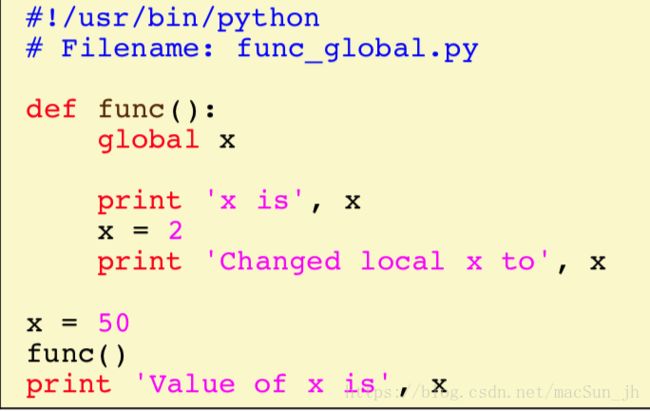python 相关
规范:
在Python中, pydoc以及单元测试要求模块必须是可导入的. 你的代码应该在执行主程序前总是检查 if __name__ == '__main__' , 这样当模块被导入时主程序就不会被执行.
def main():
...
if __name__ == '__main__':
main()
终端执行python命令方法:
chmod 777 main.py 给程序可执行的许可
./main.py
在Python中有4种类型的数——整数、长整数、浮点数和复数。
字符串:单引号' ' 双引号" " 三引号 ' ' ' ' ' ' / """ """ 使用三引号时,可包括多行字符串,引号里面可随意使用单引号和双引号。
转义字符:"\" 表示\后面是一个单引号,不然会出错 : 'What\'s your name?'
行末使用\ 代表在下一行接着继续,而不是开启新的一行
缩进很重要
运算符和用法:
运算符优先级:
结合规律
运算符通常由左向右结合,即具有相同优先级的运算符按照从左向右的顺序计算。例如,2 + 3 + 4被 计算成(2 + 3) + 4。一些如赋值运算符那样的运算符是由右向左结合的,即a = b = c被处理为a = (b = c)。
输入一个int的值
guess = int(raw_input('Enter an integer : '))
if ** :
elif ** :
else:
print ' **'
加参数:print 'x is', x
while ** :
break continue
定义函数:(*代表空格缩进)
| def sayhello() : ****print 'hello python' sayhello() |
def printmax(a,b): ****if a>b: ********print '...' ****else: a ********print '...' printmax(3,2) x=4 y=5 printmax(x,y) |
global关键字
声明变量为全局变量
如图程序输出为:
x is 50
Changed global x to 2
Value of x is 2
默认参数值:
def test(mesg,count=2):
print mesg*count
test('hello')
test('hello',5)输出: hellohello
hellohellohellohellohello
关键参数: def func(a,b=2,c=3)
func(3, 7) a=3 b=7 c=3
func(25,c=24) a=25,b=2,c=24
func(c=50,a=100) a=100,b=2,c=50
return 关键字
DocStrings 文档字符串 作用是:在函数的第一行字符串视为文档字符串。
def printMax(x, y):
'''Prints the maximum of two numbers.
The two values must be integers.'''
x = int(x)
y = int(y)
if x > y:
print x, 'is maximum'
else:
print y, 'is maximum'
printMax(3, 5)
print printMax.__doc__
输出:5 is maximum
Prints the maximum of two numbers.
The two values must be integers.
import / from..import
导入自己的模块: import name 导入模块名为name的模块
使用: name.funname()
from name import funname 导入模块中指定的函数
dir()函数
列出模块定义的标识符。标识符有函数、类和变量。
list
listname=['..','..','..']
len(listname) list的长度
for item in listname
print item, 遍历输入list
listname.append('..') 添加元素
listname.sort() 排序
listname[0] 获取第一个元素 del listname[0] 删除第一个元素
元组 元组类似list但是是不可变的
yzname=('1a','1b','1c')
len(yzname) 输出:3
yzname2=('2d','2e',yzname)
len(yzname2) 输出:3
print yzname2 输出:('2d','2e',('1a','1b','1c'))
print yzname2[2] 输出:('1a','1b','1c')
print yzname[2][2] 输出:'1c'
元组与打印语句
age = 22
name = 'Swaroop'
print '%s is %d years old' % (name, age)
print 'Why is %s playing with that python?' % name
结果:Swaroop is 22 years old
Why is Swaroop playing with that python?
字典dict name={key1:value1,key2:value2}
key不能重复,不能更改
添加元素: name[key3]=value3 删除元素: del name[key1]
计算元素数:len(name)
循环遍历:for name, address in ab.items():
print 'Contact %s at %s' % (name, address)
序列:
shoplist = ['apple', 'mango', 'carrot', 'banana']
shoplist[0] apple shoplist[1] mango
shoplist[-1] banana shoplist[-2] carrot
shoplist[1:3] mango,carrot shoplist[2:] carrot ,banana 索引从0开始,包含左,不包含右
shoplist[1:-1] mango,carrot shoplist[:] apple,mango,carrot,banana
name = 'swaroop'
name[1:3] wa name[2:] aroop
name[1:-1] waroo name[:] swaroop
参考
当你创建一个对象并给它赋一个变量的时候,这个变量仅仅 参考 那个对象,而不是表示这个对象本身!也 就是说,变量名指向你计算机中存储那个对象的内存。这被称作名称到对象的绑定。参考值的改变并不影响对象值的改变,对象值的改变必然影响参考值的改变。
shoplist = ['apple', 'mango', 'carrot', 'banana']
mylist = shoplist
字符串的方法:
name = 'Swaroop'
if name.startswith('Swa'): ture
if 'a' in name: true
if name.find('war') != -1: true
sjh = '_*_'
mylist = ['Brazil', 'Russia', 'India', 'China']
print sjh.join(mylist) 输出:Brazil_*_Russia_*_India_*_China
程序实例:
| 1.场景:重要文件需要备份。 要求:需要备份的文件和目录由一个列表指定。 备份应该保存在主备份目录中。 文件备份成一个zip文件。 zip存档的名称是当前的日期和时间。 |
#!usr/bin/env python
# -*- coding:UTF-8 -*-
import os
import time
source = '/Users/sunjiahui/PycharmProjects/test' #需要备份文件的路径
target_dir = '/Users/sunjiahui/testzip/' #备份后文件的路径
today = target_dir + time.strftime('%Y%m%d') #获取当天日期,组成备份文件自路径
now = time.strftime('%H%M%S') #获取时间
if not os.path.exists(today): #判断备份文件子路径是否创建,未创建则创建
os.mkdir(today)
print 'Successfully created directory', today
target = today + os.sep + now + '.zip' #指定备份后的文件路径以及文件名,文件后缀名
zip_command="zip -qr '%s' %s" % (target,source) #组成可执行的shell命令
if os.system(zip_command) == 0: #执行shell命令并判断是否执行成功
print 'Successful backup to', target
else:
print 'Backup FAILED'
python面向对象部分:self “相当于”java中的this,但并不是this
#!/usr/bin/python
# Filename: method.py
class Person:
def sayHi (self):
print 'Hello, how are you?'
p = Person()
p.sayHi() 创建一个类
输出:Hello, how are you?
__init__方法 给对象初始化
class Person:
def __init__(self, name):
self.name = name
def sayHi (self):
print 'Hello, my name is', self.name
p = Person('Swaroop')
p.sayHi()
继承 将父类名加括号写在子类名后面
子类初始化时,在__init__方法第一行先初始化父类:父类名.__init__(父类参数)
输入/输出 raw_input和print
文件
通过创建一个file类的对象来打开一个文件,分别使用file类 的read、readline或write方法来恰当地读写文件。最后调用close方法结束对文件的使用
#!/usr/bin/python
# -*- coding:UTF-8 -*-
poem = '''\
Programming is fun
When the work is done
if you wanna make your work also fun:
use Python! '''
f = file('/Users/sunjiahui/testzip/poem.txt', 'w') #写入poemtxt 'w'写模式
f.write(poem)
f.close() # close the file
f = file('/Users/sunjiahui/testzip/poem.txt') #读取文件 'r' 读模式(默认)
while True:
line = f.readline()
if len(line) == 0: # 判断文件是否输入结束
break
print line,
f.close()如果不使用本地绝对路径,则将会在项目下创建poem.txt
存储器 pickle/cpickle cpickle使用C编写,速度比前者快1000倍,用法相同
可以在一个文件中储存任何Python对象,之后你 又可以把它完整无缺地取出来。这被称为 持久地 储存对象。
import cPickle as p
shoplistfile = 'shoplist.data'
shoplist = ['apple', 'mango', 'carrot']
f = file(shoplistfile, 'w')
p.dump(shoplist, f) 存
storedlist = p.load(f) 取
异常
处理异常:try..except
举例:
import sys
try:
s = raw_input('Enter something --> ')
except EOFError:
print '\n具体异常'
sys.exit()
except:
print '\n总异常.'自定义异常类:
class ShortInputException(Exception):
'''A user-defined exception class.'''
def __init__(self, length, atleast):
Exception.__init__(self)
self.length = length
self.atleast = atleasttry..finally 与java的finally一样
特殊的方法
列表综合
举例: 想把原来列表中大于2的数扩大二倍,并成为一个新的列表(不包括不满足条件的)
listone = [2, 3, 4]
listtwo = [2*i for i in listone if i > 2] 输出:[6,8]
在函数中接收元组和列表 使用* 或者 **
def powersum(power, *args):
'''Return the sum of each argument raised to specified power.'''
total = 0
for i in args:
total += pow(i, power)
return total
powersum(2, 3, 4) #输出:25
powersum(2, 10) #输出:100由于在args变量前有*前缀,所有多余的函数参数都会作为一个元组存储在args中。如果使用的是**前 缀,多余的参数则会被认为是一个字典的键/值对。
lambda形式
lambda语句被用来创建新的函数对象,并且在运行时返回它们。
def make_repeater(n):
return lambda s: s*n
twice = make_repeater(2)
print twice('word') #输出:wordword
print twice(5) #输出:10exec和eval语句
exec语句用来执行储存在字符串或文件中的Python语句。例如,我们可以在运行时生成一个包含Python 代码的字符串,然后使用exec语句执行这些语句。eval语句用来计算存储在字符串中的有效Python表达式。
exec 'print "Hello World"' 输出:Hello World
eval('2*3') 输出:6
assert语句
assert语句用来声明某个条件是真的。例如,如果你非常确信某个你使用的列表中至少有一个元素,而 你想要检验这一点,并且在它非真的时候引发一个错误,那么assert语句是应用在这种情形下的理想语 句。当assert语句失败的时候,会引发一个AssertionError。
mylist = ['item']
assert len(mylist) >= 1




